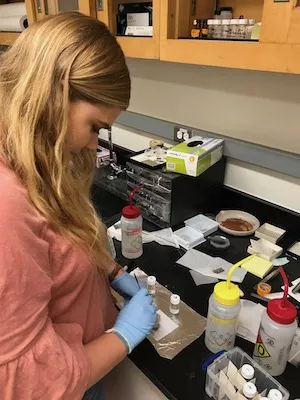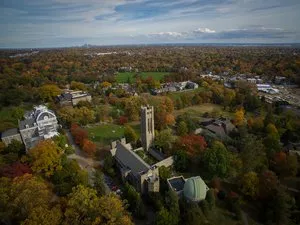Getting Involved

How do I get involved in student research?
Research with Swarthmore faculty
To apply for a summer 2026 project:
- Wednesday, November 5: Attend our research information session, 4:30 - 5:30 PM, in Science Center 199 introducing the process and expectations for summer research. A panel of students from the Society of Physics Students (SPS) who have recently participated in research in our department will also share about their experiences. See the slides here.
- Review this overview of research areas represented in our department and review individual faculty members' websites.
- Watch video summaries to learn more about faculty research projects being offered Summer 2026.
- For faculty whose research interests you, contact faculty according to the instructions each provides on the page with the video links. Note that faculty instructions vary.
- Friday, December 5: Deadline to apply for summer research at Swarthmore using this form.
- Applicants will be notified whether they are offered a position, wait-listed, or declined by late December. At this point faculty may not know how many positions they will have, so some students who are wait-listed will later receive positions.
- Late January: Students who receive an offer of a position from our department separately apply to the College for funding (more details below).
- More details about what faculty are looking for in research students, summer research, and research opportunities during the semester, are provided below.
Research off campus
If you wish to apply for off-campus summer research (often called "REU programs"):
- identify programs of interest to you by December
- request letters of recommendation from Swarthmore faculty before leaving for break
- prepare applications during winter break; most applications are due in February
- More resources about REU programs are provided at the bottom of this page
DETAILS ABOUT SUMMER RESEARCH AT SWARTHMORE
A great deal of student research with Swarthmore faculty occurs during the summer, as paid summer internships; many faculty also offer research opportunities for credit or pay during the semester.
What are faculty looking for in research students?
All of us came to Swarthmore because we love working closely with students. For a faculty member, involving a student in their research is a significant investment of time and also requires trusting that student to do their work carefully and responsibly. It also involves extensive one-on-one and small group interactions. Thus taking on a research student is a significant commitment.
We look for students who will be reliable, responsible, hard-working, persistent and patient with the challenges of research. We need to be able to count on every member of our team to show up, to communicate, and to give the work their best. These qualities and actions are far more important than facility with solving homework problems, although they also promote success in courses.
What are the odds of getting a position?
We typically have more students apply than there are positions available in any given summer, but we accommodate as many students as possible. Typically we can offer on-campus research positions to 15-20 students each summer, with the majority of positions going to rising juniors and seniors, but usually including a few rising sophomores as well.
What happens during summer research at Swarthmore and what is it like?
During the summer, students join a faculty-led research team for eight to ten weeks of full-time paid work, sometimes requiring preparation in the spring semester and/or follow-up in the fall semester. Students learn about and participate in projects devised by faculty members that are part of their ongoing research program. They interact closely with their faculty advisors, other Swarthmore research students, and often scientists and students from other colleges, universities, labs, or research institutes.
Participating in research is a good way to experience many aspects of science that are not commonly seen in the classroom. It is an important, challenging, and fun aspect of students' physics and astronomy education!
What topics of research projects are available?
See this overview of research areas in our department and also faculty members' websites for descriptions of research projects. Watch videos from faculty whose area of research interests you.
Is summer research related to the Honors Programs?
All students are encouraged to participate in research regardless of whether they are pursuing Honors. Most honors theses are based on at least one summer of full-time research, followed by one credit of thesis-writing (Phys 180 or Astro 180) in the fall. Note that a thesis is optional for students doing honors in our department.
What do I need to do to prepare for a summer of research?
Some faculty members actively recruit new students into their research groups year-round, and provide research opportunities either for credit (see Phys 94 and Astro 94) or for hourly pay during the semester. Interested students are encouraged to talk to individual faculty members about opportunities to get involved in research during the semester.
Can I apply for both Swarthmore and off-campus positions?
You will be notified whether you have been selected for a Swarthmore position before winter break, well before applications for off-campus positions are due. Some faculty will ask you to commit to working with them by mid-January, while others will be perfectly fine with students also applying for off campus positions and deciding in March if they will accept the Swarthmore position. The application will ask you to indicate whether you are willing to commit to a position in January if offered.
How does the application for College funding work?
Students receiving a summer research position at Swarthmore, including students on the waitlist, are required by the College to fill out an online application for summer funding to be submitted by mid-February, 2025. The College then awards a limited number of student stipends.
Most of the funding to support student summer research stipends (sort of a salary/scholarship, that's paid all at once at the beginning of the summer) comes from the College, while some comes from research grants obtained by individual faculty members (from the National Science Foundation, for example). There is always some uncertainty about the total number of stipends available until the spring.
Students can expect to be notified of the College's funding decision by early March. Students on the waitlist might find that positions open up for them around then, particularly if more stipends than expected are available.
The College opens up applications for on-campus summer housing in late March.
DETAILS ABOUT OFF-CAMPUS SUMMER RESEARCH OPPORTUNITIES
There are numerous research opportunities off campus during the summer. Many universities, national labs, and observatories host summer research programs for undergraduates, and the ones funded by a specific National Science Foundation initiative are called "REU" (Research Experience for Undergraduates) programs. Often these are quite competitive, and require applications to be submitted (typically) in February.
Here are several sources for summer opportunities:
- The National Science Foundation has a list of programs.
- The American Physical Society has a database of summer internships.
- Our department has compiled information about summer programs, including many non-REU programs that allow non-US citizens to participate.
- NASA, the National Labs (Los Alamos, Sandia, Livermore, Fermilab, Oak Ridge, and a few others) have their own summer internship programs.
- There are increasingly opportunities at privately funded (often theoretical physics) research institutes (Santa Fe Institute, the Perimeter Institute in Canada, the Flatiron Institute in Manhattan) for undergraduate summer research.
- Talk to faculty members to get advice and to request letters of recommendation. And ask other students who've done summer programs in the past about their experiences.
Of special interest to astronomy students:
The Keck Northeast Astronomy Consortium (KNAC) is a consortium of eight small liberal arts colleges: Swarthmore, Haverford/Bryn Mawr, Colgate, Vassar, Wesleyan, Williams, Wellesley, and Middlebury. Students from these eight schools can apply to spend the summer at one of the other seven campuses, and work on a project with a faculty member at that school. The consortium hosts a meeting every fall at which students present the results of their summer research. The meeting is open to all students, not just ones who have done the summer exchange. Applications for the KNAC exchange program for summer 2025 will be open in December 2024. All students - not just US citizens - are eligible for the KNAC program.



